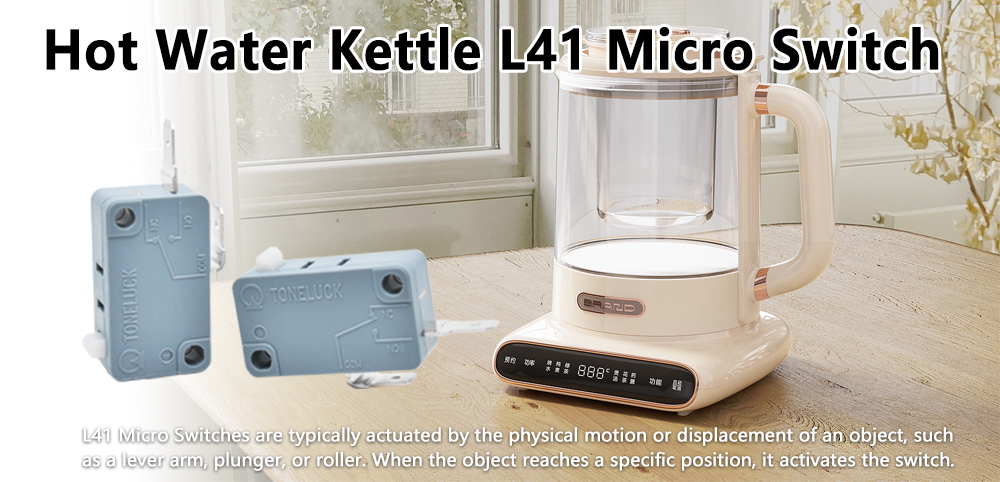The working principle of the L41 Micro Switch of the hot kettle
L41 Micro Switch used in hot kettles, also known as limit switches, serve specific functions within the appliance to ensure proper operation and safety. The primary working principle of an L41 Micro Switch in a hot kettle typically involves controlling the heating element and ensuring the kettle’s safety.
Hot kettles are designed to boil water and maintain it at a specific temperature. The L41 Micro Switch is used to control the heating element. It is connected to the kettle’s thermostat or temperature control circuit. The L41 Micro Switch is placed in a specific location within the kettle, often near the bottom. It has an actuation mechanism, such as a lever or a rod, which can move up and down as the water level changes.
The kettle’s thermostat or temperature control system is set to a desired temperature (e.g., 100°C for boiling water). When you turn on the kettle, the heating element begins to heat the water. Actuation of the L41 Micro Switch, As the water in the kettle heats up and approaches the boiling point, it generates steam. This steam rises, and as it does, it displaces the air within the kettle, increasing the pressure inside.

The rising steam generates pressure within the kettle, which is transmitted to the L41 Micro Switch’s actuation mechanism. When the water boils and enough steam pressure is created, it pushes the lever or rod of the L41 Micro Switch. When the L41 Micro Switch is actuated by the pressure generated by the boiling water and steam, it sends a signal to the kettle’s control circuit. This signal tells the kettle to turn off the heating element, effectively stopping the boiling process.
The L41 Micro Switch’s primary role in this context is to ensure that the kettle doesn’t continue heating once the water reaches its boiling point. This prevents the water from overboiling, which could lead to spillage or other safety issues. It also helps conserve energy by turning off the heating element when it’s no longer needed.
After the kettle is turned off and the water cools down, the L41 Micro Switch resets itself to its initial position. It’s ready to activate again when you decide to boil water once more. The L41 Micro Switch in a hot kettle works by sensing changes in pressure caused by the boiling water and steam. When the pressure reaches a predetermined level (indicating that the water has boiled), the switch is actuated, signaling the kettle to turn off the heating element. This ensures that the water doesn’t overheat and enhances safety and energy efficiency in the operation of the kettle.
L41 Micro Switch Key Features
An L41 Micro Switch, also known as a limit switch or a position switch, is a type of electrical switch used to detect the physical position or limits of an object or a machine. It is commonly used in various industrial and automation applications to control the movement of machinery and equipment, provide feedback on the position of a component, or trigger specific actions based on the position of an object.
1. Actuation Mechanism
L41 Micro Switches are typically actuated by the physical motion or displacement of an object, such as a lever arm, plunger, or roller. When the object reaches a specific position, it activates the switch.
2. Contact Types
L41 Micro Switches can have different types of electrical contacts, including normally open (NO), normally closed (NC), or a combination of both. The choice of contact type depends on the specific application and how the switch needs to respond to the object’s position.
3. Housing
L41 Micro Switches are often housed in rugged enclosures that protect them from environmental factors like dust, moisture, and mechanical stress. The housing design can vary depending on the intended application and the level of protection required.
4. Adjustability
Many L41 Micro Switches allow for adjustable actuation points, allowing users to set precise positions at which the switch activates or deactivates.
Contact Rating
L41 Micro Switches come in a range of contact ratings, which determine the maximum voltage and current they can handle. The selection of a L41 Micro Switch should match the electrical requirements of the application.
L41 Micro Switch Applications
L41 Micro Switches are used in industrial machines and equipment to control the movement of components, such as conveyor belts, robotic arms, and elevators. When a certain position is reached, the L41 Micro Switch can stop or reverse the movement. In industrial and manufacturing settings, L41 Micro Switches are often integrated into safety systems to ensure that machinery stops or enters a safe mode when a specific position is reached, preventing accidents or damage.
L41 Micro Switches can be found in various home appliances, such as washing machines and dishwashers, where they detect the positions of doors, lids, or other moving parts. Elevators use L41 Micro Switches to detect the floor position and to ensure the elevator stops at the correct level.
In vehicles, L41 Micro Switches are used in applications like power windows and sunroofs to detect when these components are fully open or closed. Farming equipment often incorporates L41 Micro Switches to control the movement of machineries like plows and harvesters. L41 Micro Switches are used in material handling equipment, like cranes and forklifts, to control load positioning and safety.
L41 Micro Switches can provide position feedback in various systems, allowing for precise control and automation. L41 Micro Switches are versatile components used in a wide range of applications to detect and control the position or limits of objects or machinery. They play a critical role in automation, safety, and control systems across various industries.
